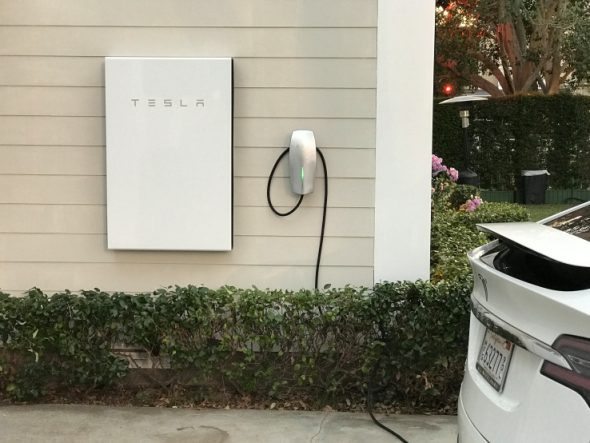Just nine months after the first batch of Tesla’s 7kWh Powerwall battery storage systems hit the Australian market, the US company has unveiled the Powerwall 2 – a smaller, sleeker second generation unit with double the energy storage capacity at nearly half the cost per kilowatt hour of its predecessor.

The new and improved 14kWh Powerwall 2 was launched on Friday night in Los Angeles alongside Tesla’s solar roofing product – a shared BIPV vision with SolarCity whose rollout rides on the success of the two companies’ planned merger.
The company also used the event to launch its latest model EV charger and a second generation commercial/industrial battery unit, the Powerpack 2.
But it was the Powerwall 2 that made the biggest splash, largely due to its doubling up of capacity and halving of costs (in terms of the price per kWh), all of which have offered a glimpse at the break-neck speed at which this game-changing technology could be evolving.
Indeed, in a Q&A following the launch, Tesla CEO Elon Musk said his company “expects to sell more Powerwalls than cars,” owing to potential demand for the product in parts of the world where power isn’t reliable or even accessible – or is very expensive, as in Australia.
On cost, according to the Tesla website, the price per unit in Australia will be $A8,000* (with GST), or just under $10,000 fully installed. According to one accredited Tesla reseller and installer, the cost of a solar an storage system, featuring 3kW of PV and one Powerwall 2, would be around $16,500.
And the specs? While the battery’s lithium-ion chemistry remains the same, the biggest change to the battery’s hardware is that it now incorporates an inverter – Tesla’s own product – which answers one of the previous model’s biggest criticisms, and goes to cutting the cost and complexity of install.
On performance, the battery’s “round trip” efficiency is listed as 90 per cent, while its peak power rating is 7kW and 5kW continuous. According to the Tesla website, one battery pack could power an average two bedroom home for an entire day, or could get a four bedroom home through an entire night, meaning that some solar homes would have the potential to cut their grid power dependence to next to nothing.
And, like its predecessor, the Powerwall 2 can also provide back-up if the electricity grid goes down.
The appearance has changed, too. At 45.3 x 29.7 x 6.1-inches, the new rectangular unit is around 40 per cent smaller than its predecessor, but weighs in at a hefty 122kg. It can be installed inside or out, and can be wall or ground mounted. It is also stackable.
As for when we will see the units in Australia, that won’t be until sometime in Q1, 2017. But according to Natural Solar CEO Chris Williams – who just returned from attending the “very exciting” launch event in LA – demand for the new generation Powerwall is already far surpassing levels seen for the 7kWh model.
“This time the response has been maybe double or triple the response for the Powerwall 1,” Williams told One Step Off The Grid in an interview on Monday.
 “The really exciting prospect here is double the battery at lower cost per kWh, lower installation rates, so the value is going be better.
“The really exciting prospect here is double the battery at lower cost per kWh, lower installation rates, so the value is going be better.
“Cost per kWh 15 per cent more than the current package, but the value that you’re getting is 100% more.
And the timing for the capacity increase looks to be spot on, despite some analysts arguing that the best value for homeowners now is in much smaller battery units.
Williams says that when the first Powerwall hit the Australian market, 95 per cent of orders his company received were for one 7kWh unit. Within just a few months, however, Williams saw that “dramatically adjust”, with many people ordering two units, to better meet their energy needs.
“The reduction per kWh of solar and of batteries is on a great trajectory,” Williams said. “There is a lot of satisfaction, for us, in being partnered with a company that is leading the way with innovation.
“Where the market is today, compared to where I thought it would be; I think we’re five or six years ahead,” he said.
Meanwhile, the original Powerwall, which made its rockstar debut not even a year ago, looks to have been consigned to the dustbin of battery storage history. Natural Solar’s Williams says his company will continue to install the 7kWh units it has in stock, but will be focusing solely on the Powerwall 2 going forward.
“This is the future for energy management – where control goes back to individual households enabling the homeowner to visibly see and control their energy usage – helping Australian families increase their independence from the grid and save thousands on their annual energy bill,” said Anthony Tannous, Tannous, the executive general manager of CSR Bradford, another accredited Australian Tesla reseller/installer.
“A typical Australian household consumes 21 kilowatt hours (kWh) per day. The Bradford Solar ChargePack including Tesla Powerwall 2.0 is capable of storing enough power to cover an average home’s evening energy usage – helping a family of four save up to $1,500 on their annual energy bill.”
*An earlier version of this article said the Powerwall 2 would retail at $8,800. The correct price is $8,000.
This article was originally published on RE sister site, One Step Off The Grid. To sign up for the weekly newsletter, click here.










